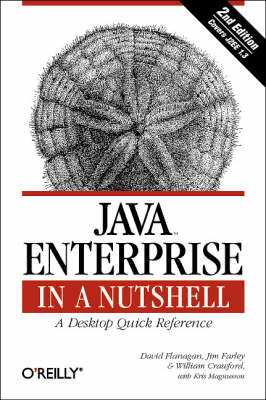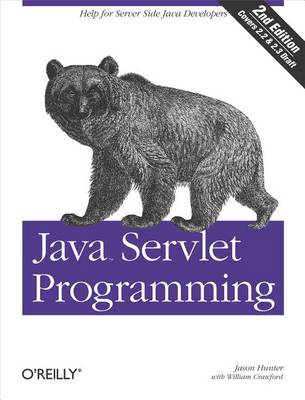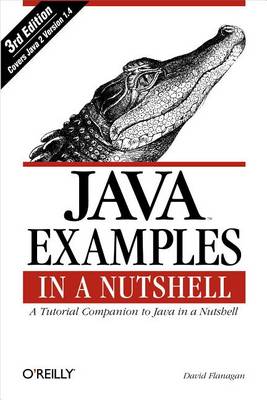Java S.
4 total works
This is a complete reference guide to Java, the programming language from Sun Microsystems. This comprehensive volume contains descriptions of all of the Java classes and their related calls and an introduction to important Java concepts. It shows programmers how to write a simple Java applet and puts Java into perspective by summarizing the differences between Java and C and by explaining the object-oriented programming constructs in Java.
Java Enterprise in a Nutshell
by Jim Farley, William Crawford, and David Flanagan
Published 5 October 1999
Completely revised and updated for the 2.0 version of Sun Microsystems Java Enterprise Edition software, this text covers all of the J2EE APIs, including RMI, Java IDL, JDBC, JNDI, Java Servlet, and Enterprise JavaBeans, with a fast-paced tutorial and compact reference on each technology. It also contains a quick reference for all of the classes in the various packages that comprise the Enterprise APIs - covering the core enterprise APIs as well as numerous standard extensions.
A few years ago, the hype surrounding applets put Java on the map as a programming language for the Web. Today, Java servlets stand poised to take Java to the next level as a Web development language. The main reason is that servlets offer a fast, powerful, portable replacement for CGI scripts. The Java Servlet API, introduced as the first standard extension to Java, provides a generic mechanism to extend the functionality of any kind of server. Servlets are most commonly used, however, to extend Web servers, performing tasks traditionally handled by CGI programs. Web servers that can support servlets include: Apache, Netscape's FastTrack and Enterprise Servers, Microsoft's IIS, O'Reilly's WebSite, and JavaSoft's Java Web Server. The beauty of servlets is that they execute within the Web server's process space and they persist between invocations. This gives servlets tremendous performance benefits over CGI programs. Yet because they're written in Java, servlets are far less likely to crash a Web server than a C-based NSAPI or ISAPI extension.
Servlets have full access to the various Java APIs and to third-party component classes, making them ideal for use in communicating with applets, databases, and RMI servers. Plus, servlets are portable between operating systems and between servers -- with servlets you can "write once, serve everywhere." Java Servlet Programming covers everything you need to know to write effective servlets and includes numerous examples that you can use as the basis for your own servlets. The book explains the servlet life cycle, showing how you can use servlets to maintain state information effortlessly. It also describes how to serve dynamic Web content, including both HTML pages and multimedia data. Finally, it explores more advanced topics like integrated session tracking, efficient database connectivity using JDBC, applet-servlet communication, inter-servlet communication, and internationalization.
Servlets have full access to the various Java APIs and to third-party component classes, making them ideal for use in communicating with applets, databases, and RMI servers. Plus, servlets are portable between operating systems and between servers -- with servlets you can "write once, serve everywhere." Java Servlet Programming covers everything you need to know to write effective servlets and includes numerous examples that you can use as the basis for your own servlets. The book explains the servlet life cycle, showing how you can use servlets to maintain state information effortlessly. It also describes how to serve dynamic Web content, including both HTML pages and multimedia data. Finally, it explores more advanced topics like integrated session tracking, efficient database connectivity using JDBC, applet-servlet communication, inter-servlet communication, and internationalization.
This companion volume to "Java in a Nutshell" picks up where that book leaves off, providing a suite of example programs for novice Java programmers and experts alike. It delivers working examples that should help users explore the wide range of what is possible with Java 1.1. Each chapter concludes with programming exercises that suggest further avenues for building on what has been learned. In addition there are programming examples for remote method invocation, database connectivity, and security important elements of the Java Enterprise APIs. Finally, the book offers a glimpse of the features of "Swing", the set of new components that are part of the forthcoming Java Foundation Classes (JFC).



